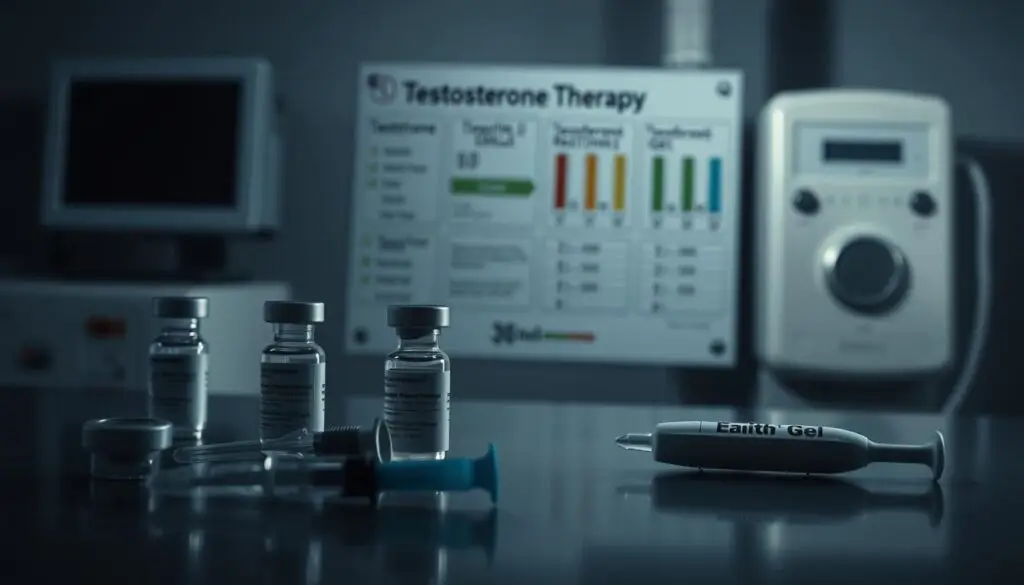You don’t have to guess when your body starts sending clear signals. Low testosterone can show up as persistent fatigue, shrinking muscle mass, a weaker sex drive, mood shifts, and thinning hair on the scalp or face.
Pay attention to patterns that don’t improve with rest or lifestyle changes. In older men, studies estimate prevalence between 19% and 39%, so a steady dip in energy or libido is not always just aging.
Urologists note additional symptoms such as erectile changes, lower orgasm intensity, and waning motivation. Tracking how often and how severe these issues are helps you decide when to seek testing and expert care.
This article gives you a clear roadmap: what to watch for now, why the hormone matters to your long-term health, and the next steps to get answers from a urologist.
Key Takeaways
- Recognize common signs: fatigue, low libido, mood shifts, and hair thinning.
- Understand that low testosterone affects both function and quality of life.
- Know the condition is common in older men and often diagnosable.
- Track symptom patterns to decide when to seek medical testing.
- Use this guide to prepare questions for a urologist and plan next steps.
What Low Testosterone Is and Why It Matters to Your Health Today
This hormone is made mainly in the testicles and steers many parts of your body. It fuels sex drive, helps build and keep muscle, supports bone strength, and steadies mood and daytime energy.
When levels drop, your body composition and metabolism can shift. You may notice more belly fat, softer muscle, and slower workout recovery. These changes often trace back to a single deficiency called testosterone deficiency (hypogonadism), which doctors diagnose by combining symptoms with blood tests.
Even subtle changes can matter. A small fall in hormone levels may include lower sex interest, mood dips, or less stamina. Tracking these shifts helps you and your clinician decide if testing and treatment belong in your plan.
| Function | What testosterone does | What low levels may include |
|---|---|---|
| Sex | Maintains libido and sexual performance | Diminished desire, erectile changes — learn more at erectile function guidance |
| Muscle & Bone | Builds muscle mass and preserves bone density | Loss of strength, higher fracture risk, softer physique |
| Mood & Energy | Regulates mood, focus, and daytime stamina | Fatigue, low motivation, mild depression |
Signs of Low Testosterone in Men
You may feel regularly drained even after a full night’s rest and proper meals. That persistent fatigue and low daytime energy is a common early symptom to take seriously.
Lower sex drive shows up as less interest in intimacy than you used to have. You may notice fewer thoughts about sex and less enthusiasm during encounters.
Erectile dysfunction can appear as trouble getting or keeping an erection. If this starts suddenly or gets worse, it strengthens the case for hormone testing.
Loss of muscle mass and strength often comes with creeping body fat, even when you keep training. You may see smaller gains at the gym and slower recovery.
Mood shifts include irritability, depressed mood, and dips in motivation. These symptoms affect your work and relationships and may be linked to hormone change.
Hair thinning and hair loss may extend beyond normal age patterns, with less beard growth or more scalp shedding than before.
Sleep quality can worsen and then amplify other symptoms, creating a cycle that reduces hormone balance and overall well-being.
“Common signs include persistent fatigue, lower sex drive, erectile difficulties, loss of muscle mass, mood swings, and hair thinning.”
| Symptom | What you feel | Next step |
|---|---|---|
| Fatigue / Low energy | Daytime slump despite rest | Track sleep, diet, get morning labs |
| Sex drive & erectile dysfunction | Less interest, trouble with erections | Record frequency, discuss with urologist |
| Muscle mass loss / Hair loss | Weaker lifts, thinning beard or scalp | Measure strength, photo log, hormone test |
Track symptoms together rather than alone. A pattern gives your clinician a clearer case for testing and a faster path to answers.
Common Causes and Risk Factors You Should Consider
Several medical and lifestyle factors often work together to reduce testosterone production. You’ll weigh natural age changes alongside modifiable factors to find what matters most for you.
Major contributors include obesity and chronic conditions. Type 2 diabetes, heart disease, COPD, high blood pressure, depression, and chronic pain frequently coexist with testosterone deficiency. Opiate medications for pain can suppress hormone output.
Primary vs. secondary causes
Primary hypogonadism comes from testicular problems such as trauma, torsion, cancer, or congenital issues.
Secondary hypogonadism stems from reduced pituitary signaling and is common with obesity and in middle-aged or older men.
- You’ll review medical conditions and lifestyle factors to spot actionable causes.
- You’ll discuss medications and sleep or stress issues that lower testosterone levels.
- You’ll consider earlier testing if you are an older man with multiple risk factors.
| Risk factor | Why it matters | Action |
|---|---|---|
| Obesity | Promotes secondary hypogonadism and lowers free testosterone | Weight loss, diet, exercise plan |
| Chronic diseases | Diabetes, heart disease, COPD often link to deficiency | Manage conditions and check morning labs |
| Medications & sleep | Opiates and poor sleep reduce testosterone levels | Review meds, treat sleep disorders |
| Testicular causes | Trauma, cancer, or congenital issues impair production | Specialist referral and targeted testing |
“Identify which causes you can change first — that often gives the fastest benefit.”
How Low T Impacts Your Daily Life and Long-Term Health
A steady drop in testosterone can quietly change how your body stores fat and how energized you feel each day.
Left untreated, you may experience increased central weight gain, poor concentration, low motivation, and memory slips. These changes can make daily tasks harder and leave you with a persistent sense that something is wrong.

Weight, focus, and a faded sense of well-being
- Weight and body composition: Extra belly fat feeds back to reduce hormone levels, and reversing that with targeted weight loss often helps restore balance.
- Cognitive and mood effects: You may find reduced focus, memory lapses, and shifts in mood that hurt work and relationships.
- Strength and daily energy: Softer muscle and lower strength make it harder to stay active, which worsens the cycle.
- Why action matters: Treating the cause rather than just the symptoms improves mood and long-term health and protects performance over time.
| Area affected | What you feel | Quick action |
|---|---|---|
| Weight & body | More belly fat, harder to lose pounds | Targeted diet and exercise; check labs |
| Mood & thinking | Low motivation, concentration loss | Track symptoms; discuss treatment |
| Strength & energy | Weaker lifts, daytime fatigue | Combine strength training with medical review |
“Weight gain and mood shifts can reinforce each other — timely testing gives you clarity and control.”
How Low T Is Diagnosed: The Tests and Thresholds
Diagnosis starts with repeat morning blood work. Testosterone levels peak in the early hours and can vary, so your clinician will order two separate morning draws to confirm any abnormal result.
If both tests show total testosterone below 300 ng/dL, a testosterone deficiency may be diagnosed (Martin Miner, MD). Your doctor will interpret those numbers together with your symptoms.
What your testing plan may include
- You’ll schedule two morning lab draws because day-to-day variation matters.
- Your clinician will use the <300 ng/dL threshold as a practical marker while reviewing your history.
- Additional bloodwork—like LH and FSH—helps tell whether the issue is primary or secondary.
- Track symptom onset, frequency, and severity so the numbers match how you feel; common signs may include libido change, erectile problems, fatigue, and mood shifts.
- Because lab variation happens, repeat testing is essential before starting long-term therapy. Bring a concise symptom log to speed decisions.
| Test | Why it matters | Next step |
|---|---|---|
| Total testosterone (morning) | Primary measurement for levels testosterone | Repeat on a second day if low |
| LH / FSH | Distinguish primary vs. secondary causes | Guide referral and treatment |
| Symptom log | Correlate labs with real-life function | Bring to your doctor visit |
“A clear symptom record plus two morning labs gives the most reliable path to diagnosis.”
Treatment Options: From Lifestyle Changes to Testosterone Therapy
Treatment decisions start with clear goals: regain energy, rebuild muscle, protect bone, or restore sex drive. Your clinician will match a plan to what matters most to you.
Lifestyle first: target weight loss, add resistance training to rebuild mass and bone strength, and normalize sleep. These steps support testosterone and often reduce the need for medical therapy.

Topical gels
Gels offer daily dosing and steady absorption. Use them as directed and cover treated skin to avoid transfer to others.
Injections
Shots like testosterone cypionate are given weekly or biweekly. They are cost-effective but can cause mood and energy “peaks and valleys.”
Long‑acting choices
Pellets (Testopel) and extended‑interval injections (Aveed) give steadier levels for 9–12 weeks and fewer clinic visits.
HCG therapy
HCG can stimulate your own production and help preserve fertility and testicular size. Discuss side effects and medical contraindications first.
“Combine medical therapy with strength training and sleep hygiene to get the best, lasting results.”
- Compare risks, monitoring plans, and labs for each option.
- Work with your doctor to tailor dosing and follow-up to your goals.
When to See a Doctor and Choosing the Right Urologist
Seek care early. You should book a visit when persistent changes reduce your energy, drive, or strength. Waiting lets symptoms worsen and narrows your options for effective care.
Pick a urologist who treats men’s hormone conditions. A specialist will interpret morning labs, explain therapy choices, and tailor treatment based on your age and health conditions.
What to discuss at your visit and how to evaluate treatment options
- Bring a concise symptom timeline, sleep notes, medications, and any chronic conditions like diabetes or heart disease.
- Ask how testosterone levels relate to your symptoms and which tests the doctor will order.
- Review medical and lifestyle options: gels, injections, long‑acting formulations, and HCG, plus monitoring plans.
- Discuss how age and existing conditions affect risks and the safest path for you.
- Agree on follow‑up timing for labs, dose checks, and side‑effect reviews so progress is measurable.
“Men should seek medical attention when symptoms are present, rather than waiting for illness to progress.”
| At the visit | What to bring | Typical next step |
|---|---|---|
| Initial evaluation | Symptom log, meds, sleep pattern | Order two morning testosterone tests |
| Risk review | Medical history (diabetes, heart disease) | Tailor therapy options and monitoring |
| Therapy discussion | Questions about gels, injections, pellets, HCG | Choose plan and set lab follow‑ups |
Conclusion
Before you commit to therapy, get clear data: two separate morning tests showing total testosterone under 300 ng/dL supports a diagnosis of deficiency. Pair testing with a short symptom log so your clinician sees the full picture.
You’re not stuck. Lifestyle steps—better sleep, smart strength training, and weight loss—boost results from medical treatment. Options include topical gels (watch for transfer), weekly or biweekly injections, long‑acting pellets, and HCG when fertility matters.
Track testosterone levels and symptoms over time to protect bone and muscle mass, restore sex drive, address erectile dysfunction, and stabilize mood. For a concise clinical overview on diagnosis and treatment, see the diagnosis and treatment guide.



